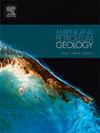新生代渤海湾盆地的非均质应变分区受原有地壳结构和斜俯冲的控制:冀中和黄骅分盆地的启示
IF 3.7
2区 地球科学
Q1 GEOSCIENCES, MULTIDISCIPLINARY
引用次数: 0
摘要
几十年来,人们对渤海湾盆地(BBB)的构造特征和地球动力学进行了广泛的研究。一般认为,新生代的渤海湾盆地受到了伸展和走向滑动应力场的叠加作用。然而,具体的盆地形成机制仍不明确。具有高时空分辨率的盆地尺度研究揭示了多相断裂过程中应变如何迁移和定位。了解这些与应变相关的过程对于破译裂谷盆地的形成机制和控制因素至关重要。本研究调查了北京断裂带西半部冀中和黄骅分盆地与断裂有关的演化和应变分区。利用高分辨率三维和二维地震数据集以及油井数据,我们展示了详细的地质剖面图、残余厚度图和断层系统,显示了新生代两种截然不同的应变分区模式。在冀中盆地,应变从东北走向的边界断层向内迁移,最后沿东北走向的裂谷轴向局部移动;在黄骅盆地,应变从南部向东北方向迁移,然后主要沿东北部近东西走向的断层局部移动。通过将我们的研究结果与之前对其他子盆地的研究结果进行整合,我们在新生代黄华盆地内发现了两个独立的伸展域。冀中亚盆地的次北交延伸域以相对稳定的NW-SE向延伸为主。相比之下,向东延伸的区域(即黄骅、渤中和辽河-辽东湾子盆地)构成了斜向延伸域,其特征是非对称的转拉开变形,并受到从西北-东南到西北-东南的顺时针旋转延伸应力场的作用。我们认为,BBB在空间上的不均匀应变分区是自中始新世以来形成的,并受先前存在的地壳结构(如郯庐断裂带)和太平洋板块斜俯冲的相互作用所控制。这两个区域之间的边界可能代表了一个过渡带,在这里,斜向辐合的边缘平行残余速度分量向陆地大幅下降。我们的研究突出了BBB地区新生代应变演化及相关地球动力学,强调了斜俯冲背景下弧后裂谷盆地内应变的复杂性。本文章由计算机程序翻译,如有差异,请以英文原文为准。
Inhomogeneous strain partitioning in the Cenozoic Bohai Bay Basin controlled by pre-existing crustal fabrics and oblique subduction: Insights from the Jizhong and Huanghua subbasins
The tectonic features and geodynamics of the Bohai Bay Basin (BBB) have been extensively studied over several decades. It is generally accepted that the Cenozoic BBB was subjected to a superimposed extensional and strike-slip stress field. However, the specific basin-forming mechanism remains ambiguous. Basin-scale studies with high spatial and temporal resolution reveal how strain migrates and localizes during multiphase rifting. Understanding these strain-related processes is crucial for deciphering the formation mechanisms and controlling factors of rift basins. This study investigates the rift-related evolution and strain partitioning in the Jizhong and Huanghua subbasins, the western half of the BBB. Using high-resolution 3D and 2D seismic datasets and well data, we present detailed geological sections, residual thickness maps, and fault systems, showing two distinct patterns of strain partitioning in the Cenozoic. In the Jizhong Subbasin, strain migrated inwards from the NE-trending boundary faults and finally became localized along the NE-trending rift axis; in the Huanghua Subbasin, strain migrated northeastwards from the southern part and then was largely localized along the near E–W-trending faults in the northeastern part. By integrating our results with previous studies of other subbasins, we identify two separate extensional domains within the Cenozoic BBB. The suborthogonal extensional domain in the Jizhong Subbasin is dominated by relatively stable NW–SE extension. In contrast, the extended areas to the east (i.e., the Huanghua, Bozhong, and Liaohe-Liaodongwan subbasins) comprise the oblique extensional domain, characterized by asymmetric transtensional pull-apart deformation and subjected to a clockwise-rotated extensional stress field from NW–SE to NNW–SSE. We suggest that the spatially inhomogeneous strain partitioning in the BBB has developed since the middle Eocene, and was controlled by the interaction of pre-existing crustal fabrics (e.g., the Tan-Lu Fault Zone) and the oblique subduction of the Pacific Plate. The boundary between the two domains may represent a transition zone where the margin-parallel residual velocity component of the oblique convergence decreased considerably landwards. Our study highlights the Cenozoic strain evolution and the associated geodynamics in the BBB, emphasizing the strain complexity within the back-arc rift basin under the oblique subduction background.
求助全文
通过发布文献求助,成功后即可免费获取论文全文。
去求助
来源期刊

Marine and Petroleum Geology
地学-地球科学综合
CiteScore
8.80
自引率
14.30%
发文量
475
审稿时长
63 days
期刊介绍:
Marine and Petroleum Geology is the pre-eminent international forum for the exchange of multidisciplinary concepts, interpretations and techniques for all concerned with marine and petroleum geology in industry, government and academia. Rapid bimonthly publication allows early communications of papers or short communications to the geoscience community.
Marine and Petroleum Geology is essential reading for geologists, geophysicists and explorationists in industry, government and academia working in the following areas: marine geology; basin analysis and evaluation; organic geochemistry; reserve/resource estimation; seismic stratigraphy; thermal models of basic evolution; sedimentary geology; continental margins; geophysical interpretation; structural geology/tectonics; formation evaluation techniques; well logging.
 求助内容:
求助内容: 应助结果提醒方式:
应助结果提醒方式:


